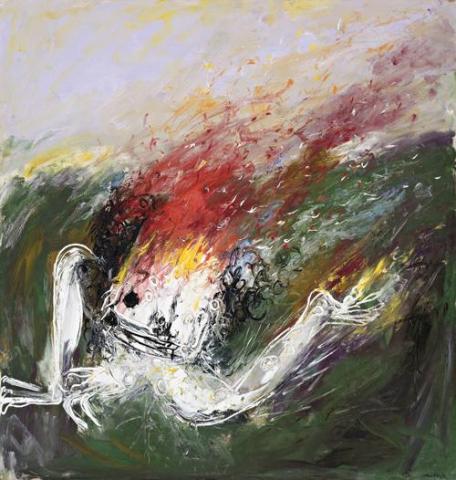FALLEN NEBUCHADNEZZAR ON FIRE, c.1966-68
Arthur Boyd
oil on canvas
174.0 x 182.5 cm
signed lower right: arthur Boyd
Arthur Tooth & Sons, London
Joseph Brown Gallery, Melbourne (inscription verso)
Private collection, New South Wales
Arthur Boyd: Recent Paintings, Arthur Tooth & Sons, London, 21 October - 8 November 1969, cat.10 (illus.)
According to the Old Testament, Nebuchadnezzar, king of ancient Babylon, fell from grace for placing self-aggrandisement before God and thus, was banished to the wilderness for seven years where '...his heart was made like the beasts, and his dwelling was with the wild asses: they fed him with grass like oxen, and his body was wet with the dew of heaven; til he knew that the most high God ruled in the kingdom of men, and that he appointeth over it whomsoever he will.'1 Although the Book of Daniel had provided inspiration to the visual arts for centuries from the medieval façade reliefs of Notre Dame LaGrande at Poitiers to the Romantic prints of visionary William Blake no painter had ever devoted himself to imagining the experiences of Nebuchadnezzar inthe wilderness before Australian modernist, Arthur Boyd.
Projecting his Nebuchadnezzar with Lear-like characteristics, Boyd embarked upon many more versions of the theme than appear in the dedicated tome published by Boase in 1972.2 Indeed, the series was, and still remains, his most sustained -featuring some of the most sumptuously executed paintings of his career, as Fallen Nebuchadnezzar on Fire illustrates. Elaborating upon the appeal of the theme, Boase suggested: 'Here is a subject thatleads immediately into Boyd's preoccupation in many other works with the fusion between man and natural forces, the involvement of man and beast... Other echoes link with Boyd's own symbolism, the sinister dark birds, the gentle mourning dog. Behind the figures there are traces of the Australian landscape of his early inspiration. But if these works are enriched with suchreferences, the myth is newly and freshly created, a second Daniel come to judgment our own contemporary obscure and secret impulses.'3
Given the artist's renowned social conscience, certainly it is not insignificant that his Nebuchadnezzar series was produced at the height of the Vietnam War when audiences internationally were assailed with images in the mass media of cruel dictatorial regimes: villages incinerated, men and women tortured, children screaming from the pain of napalm. As one author notes, 'self-immolations in protest actually took place on Hampstead Heath near Boyd's house... and once more, a biblical subject by him was seen to bean allegory of the descent of humanity in a conflicted world.'4 In Fallen Nebuchadnezzar on Fire, the protagonist is portrayed as a flaming meteorspiraling down towards a waterfall in the Australian bush - a doom presaged earlier by the symbolic felling of the tree in the king's dream. Although the sloping horizon line bears affinities with his compositions of the sixties (particularly the St Francis series), such opulent colour and light, rapid brushwork was hitherto unprecedented in Boyd's oeuvre- the white king here set against vibrant pinks and yellows of the fiery bush, with delicate nuances of gold and blue penetrating the sky.
1. Boase, T.S, Nebuchadnezzar, Thames and Hudson, London, 1972, p.20
2. Pearce, B., Arthur Boyd Retrospective, Art Gallery of New South Wales, Sydney, 1993, p. 26
3. Boase, op.cit., p.42
4. Pearce, op.cit.
VERONICA ANGELATOS
